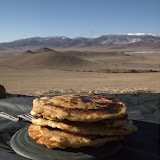
What follows is our impression of Mongolian cuisine and recipes for two Traditional Mongolian dishes we cooked by campstove: Banshtai shul (Boiled meat dumplings) and Binh (unleavened bread/pancakes).
Mongolian cuisine
Claiming that Mongolia is a land of gastronomical delights would warrant the odd rebuttal. However, it is possible to find considerable pleasure in a well-cooked traditional Mongolian meal. Whether long stretches of unsealed road cycling confounds this pleasure is debatable.
Mongolian food is heavily influenced by a combination of nomadic culture and the brutal seasons. Families with their herds of livestock are dotted across the landscape and small townships are often 100’s of kilometers apart, offering only the most basic of supplies. Add to this isolation the most extreme of weather conditions and one can appreciate that living in Mongolia is often all about survival.
Dishes are seasonal and for the most part are centred around livestock. Animals are slaughtered en-masse at the end of a summer of fattening on the pastures and carcasses are hung in sheds outside which double as freezers due to the winter temperatures. Dried meat is produced in the warmer months for when frozen and fresh meat is not available. Summer also brings a tasty array of milk based products from every variety of livestock: yoghurt, curd/cheese, fermented milk alcohol. Unfortunately we missed the milky season…or given our joint lactose intolerant status maybe it was fortunate.
Meat features prominently in most meals. It is the Mongolian staple. Every cut is utilized and as we experienced, the internal organs are treated as a delicacy. The fat is not discarded as it is thought to help create a winter layer to ward off the winter months….it is also thought by us to contribute to the hefty cardiovascular disease burden affecting the population. Wheat and water are the two additional food items available to average Mongolian family and meals are a crafty combination of all three. Simple dough (baking soda is used in some dishes) is used to form noodles, unleavened bread (binh), fried meat pancakes (khuushuur) and meat dumplings (buuz = steamed dumplings; bansh = boiled dumplings). Easily the most common dish, and often the only meal available, was tsuivan. This consists of fried home-made noodles with meat and rarely vegetables. For carb-loading cyclists with a generous supply of multivitamins, this diet is actually quite apt.
Tea (tsai) is mandatory in all gers. Mongolian tea is a salty affair sipped in ceramic bowls, or silver if you are the head of a fortunate household. After dehydrating rides in our desert sections, we’ve found the tea to be a great, albeit accidental, way to rehydrate and replace some electrolytes. However the salt can be a little difficult to handle after a while and probably contributes to the previously mentioned cardiovascular issues. In the warmer months tea is milky (suutei tsai).
Meat + tea + water + wheat + salt = most meals. Organic produce (ie vegetables) are traditionally the food of livestock. This is a nation of nomads rather than agriculturalists of course. Yet, a few root vegetables have infiltrated the larger towns. We found they were almost always limited to onion, carrot, potato and parsnip. Occasionally a tomato, apple, mandarin or cabbage may crop up in the central towns.
A third aspect of Mongolian lifestyle that shapes the cuisine is the ger. This circular felt tent is the home to around 50% of the population. In the centre of the ger lies a simple metal furnace with a large stovepipe exiting directly above. This is the source of heat and we can testify that when it is pumping the ger can turn into a sweat-tent of sorts. A large hole in the top of the furnace allows it to double as the cooking stove. Enormous, wok-like metallic bowls are placed within the hole creating a means to cook everything. In more regional places, coal and wood stoke the fire, yet elsewhere piles of dried dung provide fuel for the flames.
With a tent, a petrol based stove, some wandering across the vast countryside, being at the whim of the weather, sourcing water from wells, rivers, springs and a reliance on the products from small towns it is not a desperate stretch to compare our lifestyle (in part) to that of a nomad. Although most of our meals combined Mongolian ingredients with Western ways, we did cook a few dishes where we tried to be as authentic as possible.
Equipment
• Stove: MSR whisperlite international
• Fuel: Gasoline from petrol station
• 2 pot set (1.5L and 1L)
• Chopping board (we used our thin road atlas which had a surprisingly robust cover)
• Knife (from multi-tool)
• Tupperware containers
• Travel cutlery set
Binh
(Unleavened Bread, Mongolian pancakes or as we’ve called them Steppe-Cakes)
Settings:
Early morning campsites: alpine, lakeside and desert
Ingredients (makes 8 steppe-cakes)
• Flour (about 500g)
• Water (enough to achieve appropriate consistency)
• Baking Soda (two generous pinches)
• Salt (just a small pinch)
• Sugar
• Oil
• Honey, Jam
Sourcing Ingredients
Towns of several hundred will have most. Baking soda from bigger towns. Honey only really from the capital and the few aimag capitals (ie 20 000 pop). Water from nearby lakes, rivers, town wells or springs (all filtered). Bottled water can also be bought from most town stores.
Method
1. Mix flour, salt, water and baking soda in smaller pot to create dough (if you are Mongolian, you will have learnt the appropriate quantities at your mother’s knee)
2. Knead dough until smooth and pliable
3. Tear off small pieces and roll into flat circular pikelets using a plastic bottle as a rolling pin
4. Sprinkle with sugar
5. Fry in pot with oil until golden brown
6. Liberally apply honey and consume with an accompanying large cup of filtered coffee whilst overlooking scenery of your choosing
Banshtai Shol (steamed meat dumpling soup)
Setting:
In craggy mountain range with view of distant 4000m peaks
Ingredients:
• Flour
• Water
• Onion(1), carrot (2), potato (1 large) – diced
• Onion (1) – diced as finely as possible
• Meat (we had mutton) – sliced as finely as possible
• Oil
• Salt, pepper, stock cube, garlic pieces, universal seasoning
Sourcing ingredients
On the day of cooking we went into a ger that doubled as a guanz (roadside cafe is best translation). Armed with a Tupperware container and simple Mongolian phrases, we were able to obtain some slices of fresh meat from the long pieces hanging on the wall (1000T or 90cents AUD). Vegetables from nearby aimag capital. Stock cube and garlic pieces from Ulaanbaatar. Universal seasoning is a flavouring found in most stores.
Method
1. Mix water, flour, salt to create dough (fine consistency). Knead.
a. Cut dough into 3cm pieces
b. Roll into thin 10cm flat circular pieces with drink bottle
2. Dice the onion, carrot and potato for the soup and set aside
3. Finely dice the meat and one onion. Mix together with some salt and pepper.
4. Dumplings
a. Place a small onion-meat combination onto a dough circle and pinch the edges closed to form a crescent shaped dumpling
5. Fire up the stove
6. Fry up oil, garlic, salt, pepper, universal seasoning and onion
7. Add carrot and potato and continue frying
8. Add stock cube and water to cover and bring to boil
9. Once carrot and potato are almost soft, add dumplings and cook until the aroma of boiled meat is just right (as per Mongolian family we stayed with) this is usually about 20min (moderate simmer would be appropriate but our stove only really does violent boil)
10. Eat hot, sweat and enjoy. (As the same Mongolian family informed us, it is good and cleansing to sweat and you should wait until the sweating has subsided before leaving the table…or vestibule)
11. Enjoy starry skies free of light pollution (after a long cycling day and much food preparation we only sat down to dinner at around 10pm, just as the light was fading).
 |
| Cooking with Gas - Mongolia |



0 comments:
Post a Comment